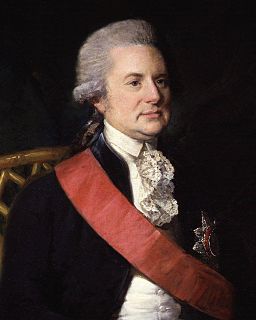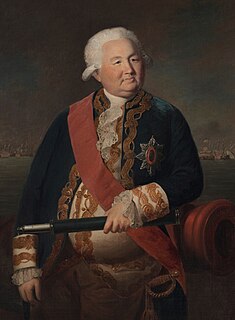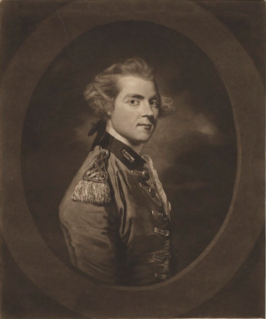
Mahadaji Schindhia: 6th Maratha Maharaja of Gwalior;

Lieutenant-General Sir Eyre Coote, KB was a British soldier and politician who sat in the House of Commons from 1768 to 1780. He is best known for his many years of service with the British Army in India. His victory at the Battle of Wandiwash is considered a decisive turning point in the struggle for control in India between Britain and France. He was known by his sepoy troops as Coote Bahadur.

George McCartney, 1st Earl McCartney, also spelt Macartney, was an Anglo-Irish statesman, colonial administrator and diplomat who served as the governor of Grenada, Madras and the British-occupied Cape Colony. He is often remembered for his observation following Britain's victory in the Seven Years' War and subsequent territorial expansion at the Treaty of Paris that Britain now controlled "a vast Empire, on which the sun never sets".

Francis Edward Rawdon-Hastings, 1st Marquess of Hastings,, styled The Honourable Francis Rawdon from birth until 1762, Lord Rawdon between 1762 and 1783, The Lord Rawdon from 1783 to 1793 and The Earl of Moira between 1793 and 1816, was an Anglo-Irish politician and military officer who served as Governor-General of India from 1813 to 1823. He had also served with British forces for years during the American Revolutionary War and in 1794 during the War of the First Coalition. He took the additional surname "Hastings" in 1790 in compliance with the will of his maternal uncle, Francis Hastings, 10th Earl of Huntingdon.

The Second Anglo-Mysore War was a conflict between the Kingdom of Mysore and the British East India Company from 1780 to 1784. At the time, Mysore was a key French ally in India, and the conflict between Britain against the French and Dutch in the American Revolutionary War sparked Anglo-Mysorean hostilities in India. The great majority of soldiers on the company side were raised, trained, paid and commanded by the company, not the British government. However, the company's operations were also bolstered by Crown troops sent from Britain, and by troops from Hanover, which was also ruled by Britain's King George III.

Eyre Coote was an Irish-born British soldier and politician who served as Governor of Jamaica. He attained the rank of general in the British Army and was created a Knight Grand Cross of the Order of the Bath before being stripped of his rank and honours in 1816 after conduct unbecoming an officer and a gentleman.

George Pigot, 1st Baron Pigot was twice the British President of the British East India Company.
Edward Montagu (1755–1799), Indian officer, was youngest son of Admiral John Montagu, and brother to Admiral Sir George Montagu and Captain James Montagu.

General James Stuart was a British Army officer who served in North America during the American Revolutionary War and took part in various campaigns in British India. He was the first General Officer Commanding, Ceylon and second Military Governor of British Ceylon. He was appointed on 1 March 1796 and was Governor until 1 January 1797. He was succeeded by Welbore Ellis Doyle.

General Sir William Medows KB was an Englishman and a general in the British Army. He entered the army in 1756 and saw action in North America, the Cape, and India. In 1788 he was appointed Governor of Bombay, transferring to become Governor of Madras in 1790.

The Madras Army was the army of the Presidency of Madras, one of the three presidencies of British India within the British Empire.
Lieutenant-General Sir Alexander Campbell, 1st Baronet, was a senior officer of the British Army during the early nineteenth century. His long and varied career saw extensive action, including engagements in Europe during the American Revolutionary War, in India during the Fourth Anglo-Mysore War and subsequently in the Peninsular War as one of the Duke of Wellington's generals. Badly wounded during the Peninsular campaign, Campbell was rewarded with a knighthood and a baronetcy, later holding a number of prestigious military commands.

The siege of Negapatam was the first major offensive military action on the Indian subcontinent following the arrival of news that war had been declared between Great Britain and the Dutch Republic, beginning the Fourth Anglo-Dutch War. A British force besieged the Dutch-controlled port of Negapatam, the capital of Dutch Coromandel, on the eastern coast of India, which capitulated after the fortification's walls were breached. The Dutch garrison consisted of 500 European troops, 5,500 local troops, and 2,000 troops of Hyder Ali, the ruler of Mysore.

Eyre Massey, 1st Baron Clarina, was an Anglo-Irish British army officer of the 18th century, known primarily for his successful action at La Belle-Famille during the French and Indian War. In 1800, he was made Baron Clarina in the Peerage of Ireland.
The Battle of Pollilur was fought on 27 August 1781, between forces of the Kingdom of Mysore under Hyder Ali and British East India Company forces led by General Eyre Coote. The battle was fought on the site of a 1780 encounter in which a Company force was almost completely routed or captured.
Andrew Stuart was a Scottish lawyer and politician who sat in the House of Commons between 1774 and 1801.
Colonel Thomas Dean Pearse was a British Army officer who served as a colonel in the Bengal Army's artillery. He took an interest in astronomy and conducted many surveys during his service in India.
The Supreme Council of Bengal was the highest level of executive government in British India from 1774 until 1833: the period in which the East India Company, a private company, exercised political control of British colonies in India. It was formally subordinate to both the East India Company's Court of Directors (board) and to the British Crown.

Major-General Sir George Adam Wood CB K.St.V KCH KMT Kt, was a British Army officer who served in the Peninsular War and fought at the Battle of Waterloo on 18 June 1815.

Sir Robert Fletcher was an officer of the East India Company and a member of parliament for Cricklade. Fletcher joined the East India Company as a junior clerk in 1757 but soon transferred to its army. As a lieutenant he was cashiered (dismissed) for insolence but was later restored. Fletcher was awarded a knighthood for gallantry in battle and rose in rank to lieutenant-colonel in command of a brigade. He was court-martialled and cashiered for the second time by Robert Clive for involvement in the 1766 Monghyr Mutiny.














